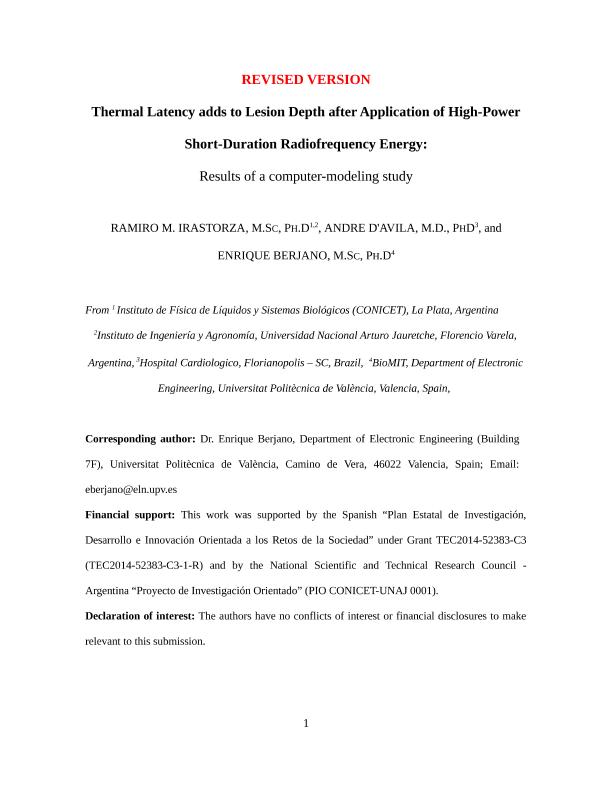Mostrar el registro sencillo del ítem
dc.contributor.author
Irastorza, Ramiro Miguel

dc.contributor.author
d'Avila, Andre
dc.contributor.author
Berjano, Enrique
dc.date.available
2018-11-02T18:39:00Z
dc.date.issued
2018-02
dc.identifier.citation
Irastorza, Ramiro Miguel; d'Avila, Andre; Berjano, Enrique; Thermal latency adds to lesion depth after application of high-power short-duration radiofrequency energy: Results of a computer-modeling study; Wiley Blackwell Publishing, Inc; Journal Of Cardiovascular Electrophysiology.; 29; 2; 2-2018; 322-327
dc.identifier.issn
1045-3873
dc.identifier.uri
http://hdl.handle.net/11336/63524
dc.description.abstract
Introduction: The use of ultra-short RF pulses could achieve greater lesion depth immediately after the application of the pulse due to thermal latency. Methods and results: A computer model of irrigated-catheter RF ablation was built to study the impact of thermal latency on the lesion depth. The results showed that the shorter the RF pulse duration (keeping energy constant), the greater the lesion depth during the cooling phase. For instance, after a 10-second pulse, lesion depth grew from 2.05 mm at the end of the pulse to 2.39 mm (17%), while after an ultra-short RF pulse of only 1 second the extra growth was 37% (from 2.22 to 3.05 mm). Importantly, short applications resulted in deeper lesions than long applications (3.05 mm vs. 2.39 mm, for 1- and 10-second pulse, respectively). While shortening the pulse duration produced deeper lesions, the associated increase in applied voltage caused overheating in the tissue: temperatures around 100 °C were reached at a depth of 1 mm in the case of 1- and 5-second pulses. However, since the lesion depth increased during the cooling period, lower values of applied voltage could be applied in short durations in order to obtain lesion depths similar to those in longer durations while avoiding overheating. Conclusion: The thermal latency phenomenon seems to be the cause of significantly greater lesion depth after short-duration high-power RF pulses. Balancing the applied total energy when the voltage and duration are changed is not the optimal strategy since short pulses can also cause overheating.
dc.format
application/pdf
dc.language.iso
eng
dc.publisher
Wiley Blackwell Publishing, Inc

dc.rights
info:eu-repo/semantics/openAccess
dc.rights.uri
https://creativecommons.org/licenses/by-nc-sa/2.5/ar/
dc.subject
CARDIAC ABLATION
dc.subject
COMPUTER MODEL
dc.subject
RF ABLATION
dc.subject
THERMAL LATENCY
dc.subject.classification
Ingeniería de Sistemas y Comunicaciones

dc.subject.classification
Ingeniería Eléctrica, Ingeniería Electrónica e Ingeniería de la Información

dc.subject.classification
INGENIERÍAS Y TECNOLOGÍAS

dc.title
Thermal latency adds to lesion depth after application of high-power short-duration radiofrequency energy: Results of a computer-modeling study
dc.type
info:eu-repo/semantics/article
dc.type
info:ar-repo/semantics/artículo
dc.type
info:eu-repo/semantics/publishedVersion
dc.date.updated
2018-10-22T21:53:16Z
dc.journal.volume
29
dc.journal.number
2
dc.journal.pagination
322-327
dc.journal.pais
Reino Unido

dc.journal.ciudad
Londres
dc.description.fil
Fil: Irastorza, Ramiro Miguel. Consejo Nacional de Investigaciones Científicas y Técnicas. Centro Científico Tecnológico Conicet - La Plata. Instituto de Física de Líquidos y Sistemas Biológicos. Universidad Nacional de La Plata. Facultad de Ciencias Exactas. Instituto de Física de Líquidos y Sistemas Biológicos; Argentina. Universidad Nacional Arturo Jauretche; Argentina
dc.description.fil
Fil: d'Avila, Andre. Hospital Cardiologico de Florianopolis; Brasil
dc.description.fil
Fil: Berjano, Enrique. Universidad Politécnica de Valencia; España
dc.journal.title
Journal Of Cardiovascular Electrophysiology.

dc.relation.alternativeid
info:eu-repo/semantics/altIdentifier/doi/http://dx.doi.org/10.1111/jce.13363
dc.relation.alternativeid
info:eu-repo/semantics/altIdentifier/url/https://onlinelibrary.wiley.com/doi/abs/10.1111/jce.13363
Archivos asociados
